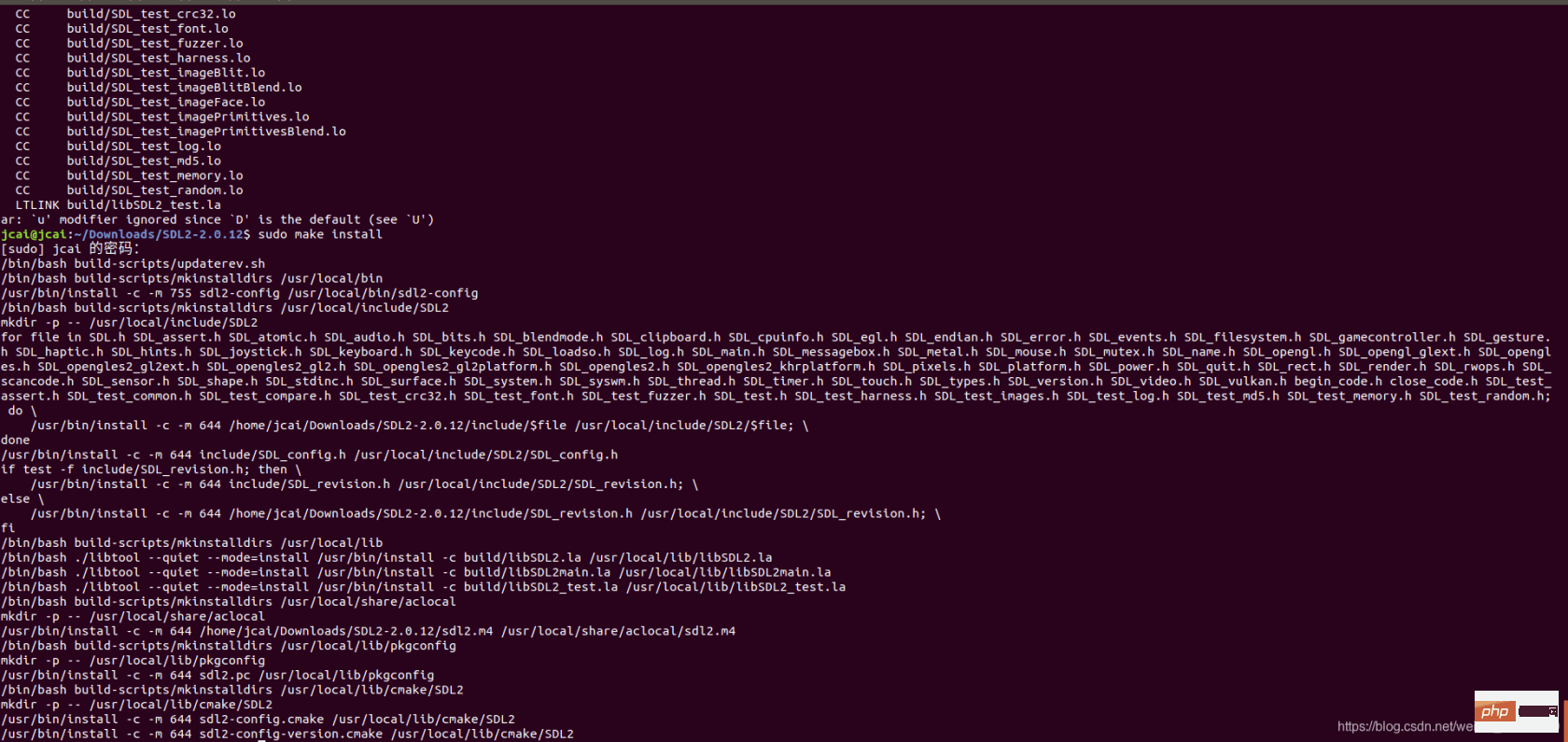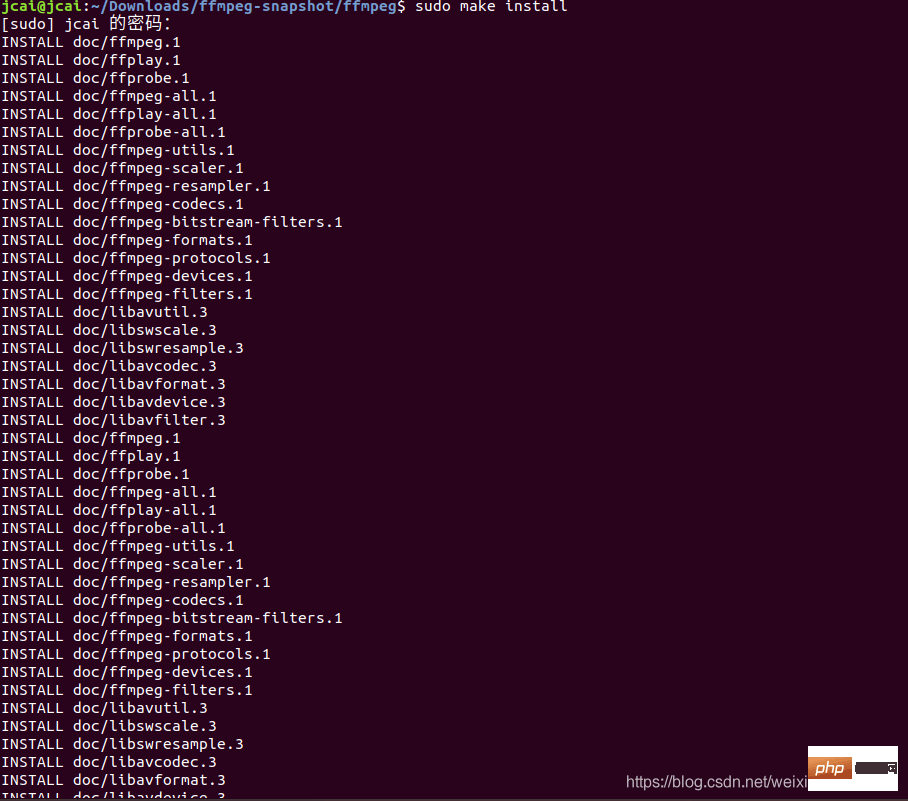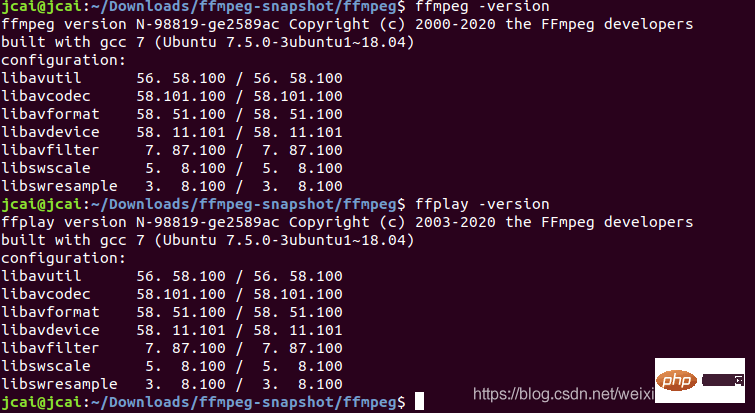 PHP Framework
PHP Framework
 Laravel
Laravel
 Detailed explanation of how laravel installs FFmpeg and processes video files
Detailed explanation of how laravel installs FFmpeg and processes video files
Detailed explanation of how laravel installs FFmpeg and processes video files
Ubuntu 18.04 Install FFmpeg
1. Download the source code, compile and install
1.1 Download the source code
github address: github.com/PHP-FFMpeg/PHP-FFMpeg
##1.2 Install dependent libraries
There are three main installations: yasm, sdl1 .2 and sdl2.0安装 yasmsudo apt-get install yasm 安装sdl1.2sudo apt-get install libsdl1.2-dev 安装 sdl2.0sudo apt-get install libstdl2-devsudo apt-get install libstdl2-dev
Download the latest version from the official website: www.libsdl.org/download-2.0.php
Unzip Then enter the directory and execute the following commands in sequence:
./configure make sudo make install
##1.3 Compile and install ffmpeg Enter the ffmpeg folder and execute the following commands in sequence:
Enter the ffmpeg folder and execute the following commands in sequence:
./configuremakesudo make install
 Insert picture description here1.4 Test whether the installation is successful
Insert picture description here1.4 Test whether the installation is successful
ffmpeg -version ffplay -version
 laravel installation
laravel installation
Extensioncomposer require php-ffmpeg/php-ffmpeg
The introduction is completed. It needs to formulate two configuration file information for us to use normally, which is the ffmpeg and ffprobe mentioned above
1.2. Global configuration
Add code to
<div class="code" style="position:relative; padding:0px; margin:0px;"><pre class="brush:php;toolbar:false"> public function boot()
{
$this->registerSingleObject();
}
private function registerSingleObject()
{// $ffmpeg = FFMpeg::create(array(// 'ffmpeg.binaries' => '/usr/local/ffmpeg/ffmpeg',// 'ffprobe.binaries' => '/usr/local/ffmpeg/ffprobe',// 'timeout' => 3600, // The timeout for the underlying process// 'ffmpeg.threads' => 12, // The number of threads that FFMpeg should use// ));
$this->app->singleton('ffmpeg', function ($app) {
return FFMpeg::create([
'ffmpeg.binaries' => '/usr/local/ffmpeg/ffmpeg',
'ffprobe.binaries' => '/usr/local/ffmpeg/ffprobe',
]);
});
$this->app->singleton('ffprobe', function ($app) {
return FFProbe::create([
'ffprobe.binaries' => '/usr/local/ffmpeg/ffprobe',
]);
});
}</pre><div class="contentsignin">Copy after login</div></div>Use singleton mode to obtain
and FFProbe objects, where exec('which ffmpeg') is to obtain program location information in order to create a class
Basic packageExample:
The first second of the video is the cover- Get the basic information of the video
<?php namespace AppHelpers;use FFMpegCoordinateTimeCode;use IlluminateSupportStr;class FFMpegUtil{ // 获取视频信息 public static function getVideoInfo($streamPath) { $ffprobe = app('ffprobe'); $stream = $ffprobe->streams($streamPath)->videos()->first(); return $stream ? $stream->all() : []; } // 截取 public static function getCover($streamPath, $fromSecond) { $ffmpeg = app('ffmpeg'); $video = $ffmpeg->open($streamPath); $frame = $video->frame(TimeCode::fromSeconds($fromSecond)); //提取第几秒的图像 $fileName = 'video/' . Str::random(12) . '.jpg'; if (!is_dir(storage_path("video"))) { mkdir(storage_path("video"), 0777); } $frame->save(storage_path($fileName)); return $fileName; }}Copy after login
Business useThe video passed in by the Request object is Example
public function saveVideotoQiniu($file)
{
Auth::loginUsingId(1);
if ($user = getUser()) {
// 1.判断是否存在此视频
$path = $file->getRealPath();
$hash = md5_file($path);
$video = Video::firstOrNew(['json->hash' => $hash]);
if ($video->id) {
$video->touch();
return $video;
}
// 2.保存到 云
$cdn_path = $this->saveFile($file);
$db_path = getPath($cdn_path);
// 3.获取截图
$fileName = FFMpegUtil::getCover($path, 1);
$image = $this->saveImage(new UploadedFile(storage_path($fileName), 'file.jpg'));
//4.设置视频信息
$data = [];
$data = FFMpegUtil::getVideoInfo($path);
$duration = array_get($data, 'duration');
$duration = $duration > 0 ? ceil($duration) : $duration;
$video->path = $db_path;
$video->user_id = $user->id;
$video->setJsonData('width', array_get($data, 'width'));
$video->setJsonData('height', array_get($data, 'height'));
$video->duration = $duration;
$video->setJsonData('cover', $image->path);
$video->save();
}
} in the example is a function that uploads images to the cloud and returns the uploaded image URLFor more laravel technical articles, please visit
The above is the detailed content of Detailed explanation of how laravel installs FFmpeg and processes video files. For more information, please follow other related articles on the PHP Chinese website!

Hot AI Tools

Undresser.AI Undress
AI-powered app for creating realistic nude photos

AI Clothes Remover
Online AI tool for removing clothes from photos.

Undress AI Tool
Undress images for free

Clothoff.io
AI clothes remover

AI Hentai Generator
Generate AI Hentai for free.

Hot Article

Hot Tools

Notepad++7.3.1
Easy-to-use and free code editor

SublimeText3 Chinese version
Chinese version, very easy to use

Zend Studio 13.0.1
Powerful PHP integrated development environment

Dreamweaver CS6
Visual web development tools

SublimeText3 Mac version
God-level code editing software (SublimeText3)

Hot Topics
 PHP vs. Flutter: The best choice for mobile development
May 06, 2024 pm 10:45 PM
PHP vs. Flutter: The best choice for mobile development
May 06, 2024 pm 10:45 PM
PHP and Flutter are popular technologies for mobile development. Flutter excels in cross-platform capabilities, performance and user interface, and is suitable for applications that require high performance, cross-platform and customized UI. PHP is suitable for server-side applications with lower performance and not cross-platform.
 How to use object-relational mapping (ORM) in PHP to simplify database operations?
May 07, 2024 am 08:39 AM
How to use object-relational mapping (ORM) in PHP to simplify database operations?
May 07, 2024 am 08:39 AM
Database operations in PHP are simplified using ORM, which maps objects into relational databases. EloquentORM in Laravel allows you to interact with the database using object-oriented syntax. You can use ORM by defining model classes, using Eloquent methods, or building a blog system in practice.
 Analysis of the advantages and disadvantages of PHP unit testing tools
May 06, 2024 pm 10:51 PM
Analysis of the advantages and disadvantages of PHP unit testing tools
May 06, 2024 pm 10:51 PM
PHP unit testing tool analysis: PHPUnit: suitable for large projects, provides comprehensive functionality and is easy to install, but may be verbose and slow. PHPUnitWrapper: suitable for small projects, easy to use, optimized for Lumen/Laravel, but has limited functionality, does not provide code coverage analysis, and has limited community support.
 Laravel - Artisan Commands
Aug 27, 2024 am 10:51 AM
Laravel - Artisan Commands
Aug 27, 2024 am 10:51 AM
Laravel - Artisan Commands - Laravel 5.7 comes with new way of treating and testing new commands. It includes a new feature of testing artisan commands and the demonstration is mentioned below ?
 Comparison of the latest versions of Laravel and CodeIgniter
Jun 05, 2024 pm 05:29 PM
Comparison of the latest versions of Laravel and CodeIgniter
Jun 05, 2024 pm 05:29 PM
The latest versions of Laravel 9 and CodeIgniter 4 provide updated features and improvements. Laravel9 adopts MVC architecture and provides functions such as database migration, authentication and template engine. CodeIgniter4 uses HMVC architecture to provide routing, ORM and caching. In terms of performance, Laravel9's service provider-based design pattern and CodeIgniter4's lightweight framework give it excellent performance. In practical applications, Laravel9 is suitable for complex projects that require flexibility and powerful functions, while CodeIgniter4 is suitable for rapid development and small applications.
 How do the data processing capabilities in Laravel and CodeIgniter compare?
Jun 01, 2024 pm 01:34 PM
How do the data processing capabilities in Laravel and CodeIgniter compare?
Jun 01, 2024 pm 01:34 PM
Compare the data processing capabilities of Laravel and CodeIgniter: ORM: Laravel uses EloquentORM, which provides class-object relational mapping, while CodeIgniter uses ActiveRecord to represent the database model as a subclass of PHP classes. Query builder: Laravel has a flexible chained query API, while CodeIgniter’s query builder is simpler and array-based. Data validation: Laravel provides a Validator class that supports custom validation rules, while CodeIgniter has less built-in validation functions and requires manual coding of custom rules. Practical case: User registration example shows Lar
 PHP code unit testing and integration testing
May 07, 2024 am 08:00 AM
PHP code unit testing and integration testing
May 07, 2024 am 08:00 AM
PHP Unit and Integration Testing Guide Unit Testing: Focus on a single unit of code or function and use PHPUnit to create test case classes for verification. Integration testing: Pay attention to how multiple code units work together, and use PHPUnit's setUp() and tearDown() methods to set up and clean up the test environment. Practical case: Use PHPUnit to perform unit and integration testing in Laravel applications, including creating databases, starting servers, and writing test code.
 Laravel vs CodeIgniter: Which framework is better for large projects?
Jun 04, 2024 am 09:09 AM
Laravel vs CodeIgniter: Which framework is better for large projects?
Jun 04, 2024 am 09:09 AM
When choosing a framework for large projects, Laravel and CodeIgniter each have their own advantages. Laravel is designed for enterprise-level applications, offering modular design, dependency injection, and a powerful feature set. CodeIgniter is a lightweight framework more suitable for small to medium-sized projects, emphasizing speed and ease of use. For large projects with complex requirements and a large number of users, Laravel's power and scalability are more suitable. For simple projects or situations with limited resources, CodeIgniter's lightweight and rapid development capabilities are more ideal.





